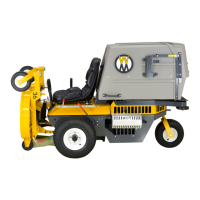Operating Instructions
27
Parking Brake
The parking brake functions by locking a detent arm
to a cog inside the transaxle. Moving the lever FOR-
WARD engages the parking brake; moving the le-
ver BACKWARD releases the brake.
IMPORTANT: Stop the tractor completely before
engaging the parking brake. The parking brake
uses a positive mechanical lock similar to the PARK
position on an automotive automatic transmission.
If the tractor is moving when the brake is engaged,
it will result in sudden stoppage and possible inter-
nal damage to the transaxle.
NOTE: If pressure on the parking brake (e.g.,
parked on a hill) makes it impossible to release the
parking brake with the parking brake lever, move the
mower gently forward or backward to allow the
brake detent to release.
Parking Brake Engaged
Parking Brake Disengaged
Transaxle Lockout Arms
The transaxle lockout arms disengage the transax-
les. By lifting the arms up and locking them into
place with the shoulder on the arm in the chassis
notch, the transaxles are released to permit free-
wheeling. By releasing the arms and recessing
them back toward the chassis, the transaxles are
engaged for normal operation. The transaxle arms
in the LOCKOUT position are used to enable mov-
ing the machine without the engine running (e.g., for
service). Refer to TRANSAXLE LOCKOUTS in this
section for operating instructions.
NOTE: The transaxle lockout arms ends should be
completely retracted against the chassis, otherwise
operation of the transaxle may be erratic.
Hydro Lockout
Arms
Hydro Lockout Arm Location

